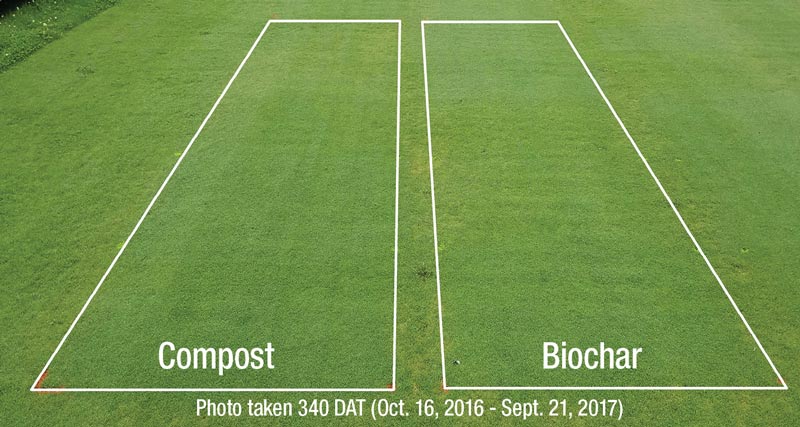
Photo by Joseph Roberts
Organic amendments offer an alternative tool for managing dollar spot (Clarireedia species). A two-year trial was initiated in late 2016 on 007 creeping bentgrass (Agrostis stolonifera L.) maintained as a golf course fairway to evaluate the impact of fertility and fungicide source on dollar spot development in a newly established fairway.
We evaluated a municipal waste compost and a biochar applied at establishment and as a topdressing applied biannually; a vermicompost + fertility treatment; a standard fertility treatment; and no treatment. Nitrogen fertility levels for all treatments were ~4.2 pounds of nitrogen/1,000 square feet (205 kilograms/hectare) annually.
Subplot fungicide treatments were applied as a 14-day contact, contact threshold, 14-day penetrant, penetrant threshold, and none. Threshold treatments were made when more than two infection centers were counted on two of four replicates.
The most consistent treatments for dollar spot reduction during periods of high pressure were the biochar, vermicompost and standard fertility treatments. Municipal waste compost treatments were more effective in the spring of each growing season. When considering seasonal control of dollar spot, all fertility treatments were similar in 2017. In 2018, the greatest reductions came from the biochar, vermicompost and standard fertility treatments.
All fungicide treatments effectively reduced dollar spot when applied at designated 14-day intervals. In 2017, the vermicompost + standard fertility treatment provided the longest duration of control for both threshold treatments. In 2018, amendments had little to no effect on residual fungicide control.
Preliminary data suggests that nitrogen availability is the driving factor for fertility-mediated dollar spot suppression.
— Cody Beckley and Joseph Roberts, Ph.D., University of Maryland, College Park, Md.
Editor’s note: A version of this summary was published in the 2018 ASA-CSSA Meeting Abstracts, ASA and CSSA, Madison, Wis.
Teresa Carson is GCM’s science editor.